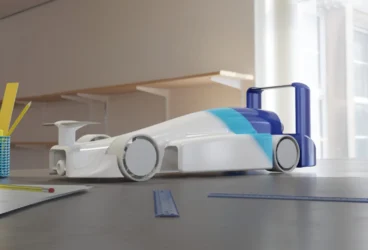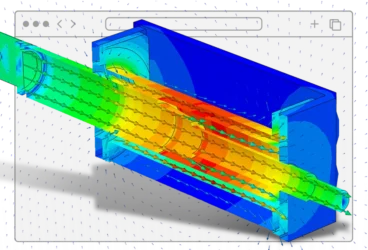Finite element analysis (FEA) is an extremely useful tool in the field of civil engineering for numerically approximating physical structures that are too complex for regular analytical solutions. Consider a concrete beam with support at both ends, facing a concentrated load on its center span. The deflection at the center span can be determined mathematically in a relatively simple way, as the initial and boundary conditions are finite and in control. However, once you transport the same beam into a practical application, such as within a bridge, the forces at play become much more difficult to analyze with simple mathematics.
Within the fields of structural and civil engineering, there are several such problems where FEA can be used to simplify a structure and understand its overall behavior.

As the field of computer-aided engineering (CAE) has advanced, so have FEA tools, with tremendous benefit to the civil engineering sector. The use of advanced FEA tools has not only led to more innovative and efficient products but also furthered the development of accurate design methods.
FEA in Structural Engineering
Whether you are building a simple residential building or the next Burj Khalifa, understanding the structural behavior and integrity of your building is extremely important to ensure the safety of its occupants.
Structural analysis involves determining the behavior of a structure when it is subjected to loads, such as those resulting from gravity, wind, or even in extreme cases natural disasters (e.g., earthquakes). Using basic concepts of applied mathematics, any built structure can be analyzed—buildings, bridges, dams or even foundations.
For example, in the right conditions, a structure such as the Burj Khalifa would oscillate by up to 3m at its highest point. Imagine living on the top floor and being subjected to this kind of motion. For more reasons than one (nauseated inhabitants included), this kind of motion needs to be controlled, and most structures use a damper to reduce the motion. Taipei 101 has a famous tuned mass damper as shown in the video below.
However, in contrast to Taipei 101, rather than take valuable space with a damper, the team of architects and engineers responsible for the Burj Khalifa instead specifically designed its shape to “confuse” winds, and therefore reduce oscillation from wind loads. To see this unique shape in action, you can check out the below simulation video created with SimScale, or if you’re interested to read further, check out this Quora answer: “How does Burj Khalifa Survive Wind Loads“.
On the other of the spectrum, earthquakes are a major concern in several highly populated parts of the world. When it comes to natural disasters, a large number of building codes are not up to standard and can often result in devastating casualties. For example, in the 1985 Mexico City earthquake, a significant portion of the damage occurred to buildings that had between 8 – 15 stories. Buildings that were taller or shorter fared much better. Why? The frequency of the earthquakes seismic waves happened to match the natural frequency of the mid-sized buildings, causing them to oscillate more violently, eventually leading them to collapse. The video below provides a concise explanation of the forces behind this movement and how it can be reduced.
While standard solutions like the moment distribution method, unit load method, or the strain energy formula, can be used to determine the behavior of simple structures (such as cantilevered beams, supported beams or trusses ). For non-conventional structures, we have to go deeper.
Originally, civil engineers used laboratory experiments to solve these design problems, especially in regards to the behavior of the steel structures when subjected to high wind loads and earthquakes. However, such reliance on laboratory testing was costly and not immediately accessible. Thus, structural codes were developed. These codes made it easier for engineers to define what sort of behavior was acceptable and safe for standard structures. However, with the recent advent of accessible CAE tools, designing, testing and guaranteeing the safety of an innovative building project and its materials has become easier, faster, and significantly cheaper.
The purpose of a helmet is to protect the person who wears it from a head injury during impact. In this project, the impact of a human skull with and without a helmet was simulated with nonlinear dynamic analysis. Download this case study for free.
Using FEA in Other Areas of Civil Engineering
Innovative Building Materials
Concrete has been a building material for a very long time. There are many phenomena like alkali-silica reactions where research continues. Why does concrete crack and how does the composition influence the crack growth? Can we create self-healing materials?
One of the biggest ifs in an FEA simulation is the accurate determination of material properties. This is where novel research areas like multiscale modeling come into the picture. Using a multiscale model, one is able to use the microstructure (or otherwise each individual component property) to determine the property of the concrete (or otherwise the property of the whole).
Sedimentation, Erosion & Hydrology
The motion of water produced in coastal areas is more predominant than inland waterways. Generation of high current waves, tides, ocean currents, storm surges, tsunamis, wind currents, etc. bring complications, and along with water particles cause subsequent damage and destruction of marine structures.
In the context of coastal flow problems, the boundary conditions of reflection and diffraction of wave-current complicate the civil engineers to analyze the same to get the solutions. Thus, coastal flow modeling (finite element modeling of fluid flows) and analysis based on numerical-empirical methodology is of today’s trend.
It is not just the coastal areas but also the catchment regions where hydrological models have been used over the last decades to understand the flow of water in porous soil and thus contributing to the groundwater levels.
While linear static analysis of hydrological projects like dams considers the load of the river on the dam, nonlinear analysis is needed to comprehensively consider the effect of the conveyance system including the inner cushion surface, outer surface of steel liner tuber to face water contact, and contact between concrete and steel liner, etc..
Download this free case study to learn how the SimScale platform was used to investigate a ducting system and optimize its performance.
SimScale Public Projects for Civil Engineering Applications
You can also look at several public projects on the SimScale database related to simulations for civil engineering.
- Static Analysis of an Elastomeric Bearing Pad: This project addresses static behavior of elastomeric bearing pads that are commonly used in bridge and other constructions for vibration isolation.
- Modal Analysis of Truss Bridge Design: If the bridge were to be considered as a truss, then modal analysis is essential to the design process.
Conclusion
While the overall applications of FEA in civil engineering are innumerable, the potential is only increasing. Even more, it is predicted to continue its growth and become a potential market of over USD 10B by just 2020. Engineers have realized that it is not the stronger structures that survive, but the smarter ones. In this long-term goal, CAE has become more appreciated for the value addition it brings to the table; especially today when cloud-based simulation tools like SimScale no longer make CAE just a tool for larger companies, but also for small to medium-sized enterprises.




